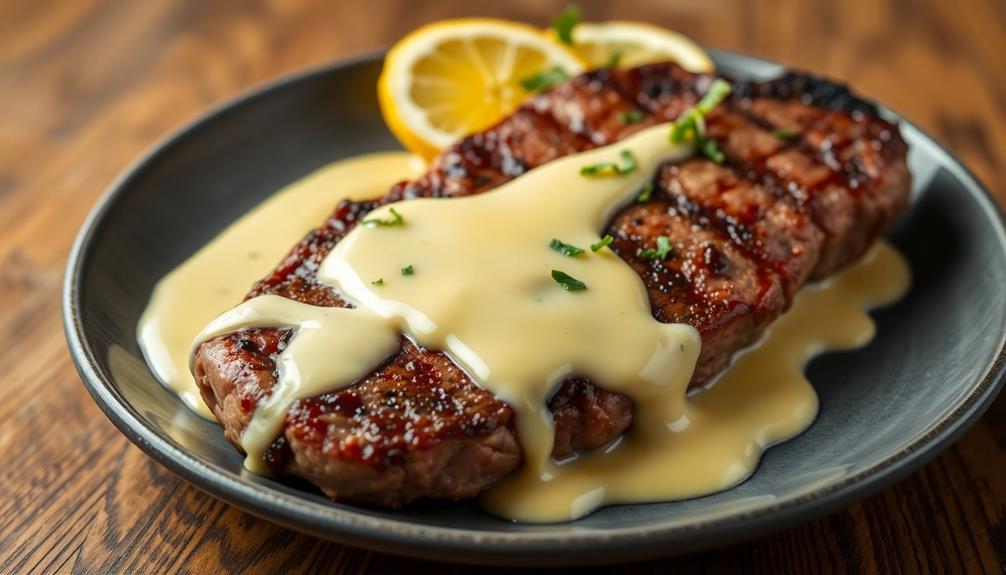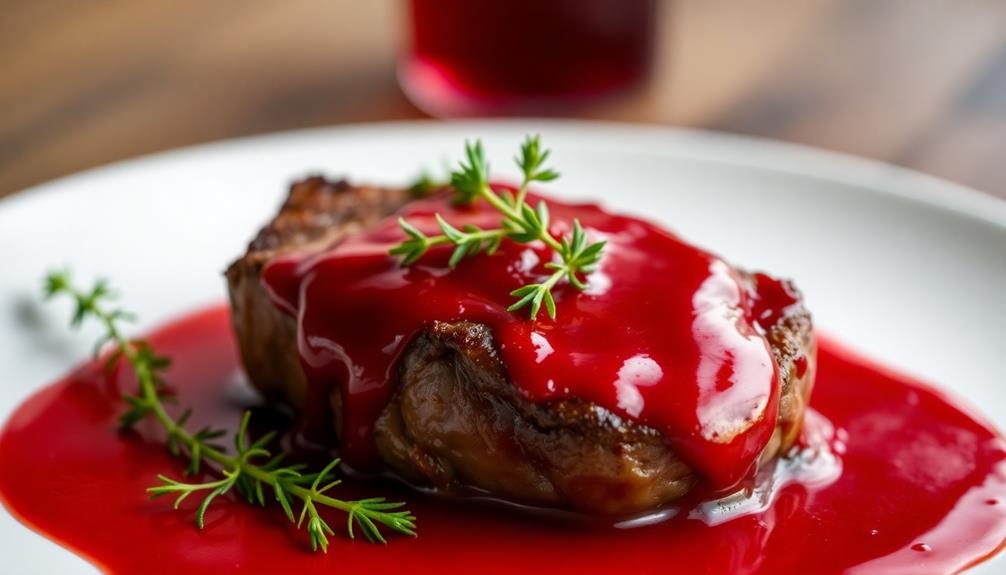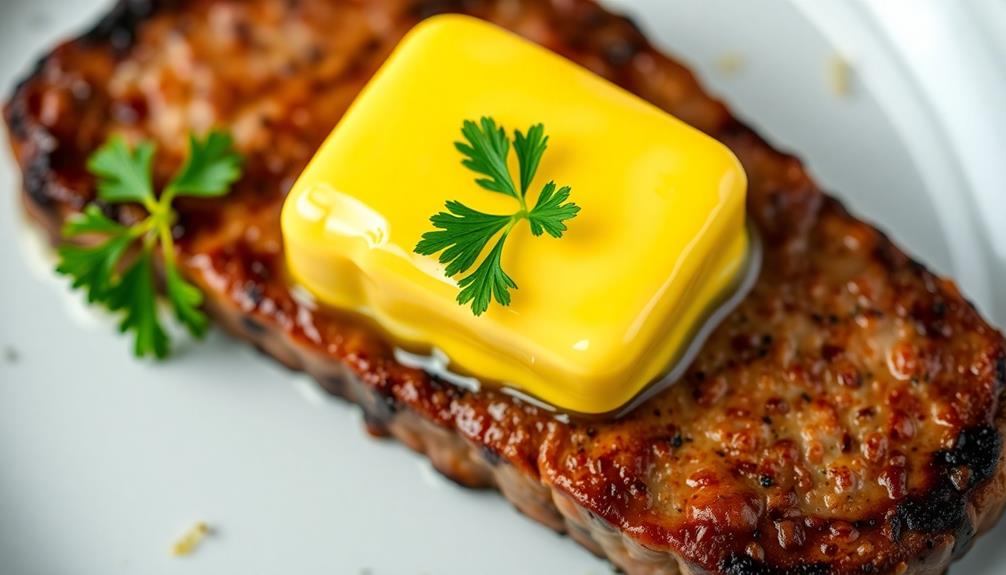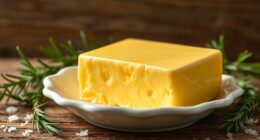Mastering hollandaise sauce is the key to leveling up your brunch game! This creamy, golden French mother sauce dates back to the 18th century and has captivated chefs ever since. Start by whisking egg yolks and lemon juice until smooth, then slowly drizzle in melted butter while whisking constantly. Season with salt and pepper, then gently heat the sauce over simmering water, stirring to prevent scrambling. Serve this velvety delight over poached eggs and enjoy the flavor explosion. With a few simple techniques, you'll be making restaurant-worthy hollandaise at home. And there's more where that came from…
Key Takeaways
- Hollandaise sauce is a quintessential French mother sauce known for its rich, creamy, and velvety texture, perfect for elevating brunch dishes like eggs Benedict.
- Mastering the delicate technique of continuously whisking egg yolks, slowly incorporating melted butter, and gently heating the sauce is crucial for achieving the signature silky consistency.
- Properly seasoning the sauce with lemon juice, salt, and white pepper enhances the overall flavor profile, while optional ingredients like lemon zest or paprika can introduce unique variations.
- Gently heating the sauce over a double boiler while whisking prevents curdling and maintains the desired pourable consistency, ensuring the sauce is served at its best quality.
- Patience, attention to detail, and continuous practice are essential to becoming proficient in the art of crafting the perfect hollandaise sauce, transforming ordinary brunch dishes into culinary masterpieces.
History

Originating in 18th-century France, hollandaise sauce has a storied history as one of the five "mother sauces" of classical cuisine. This creamy, golden-hued delight has captivated the hearts and palates of chefs and diners alike for centuries.
Its creation is often attributed to French chef Antoine Carême, who's credited with codifying and refining the five mother sauces – including hollandaise – in the early 1800s. These foundation sauces served as the building blocks for countless other culinary creations, elevating simple dishes into gastronomic masterpieces.
Hollandaise's rich, velvety texture and tangy, buttery flavor make it a versatile companion, from classic eggs benedict to grilled asparagus.
Its popularity has endured, with modern chefs continuously seeking to perfect this beloved sauce. Whether you're a seasoned home cook or a culinary enthusiast, mastering the art of hollandaise is a rewarding journey that'll have your taste buds dancing with delight.
Recipe
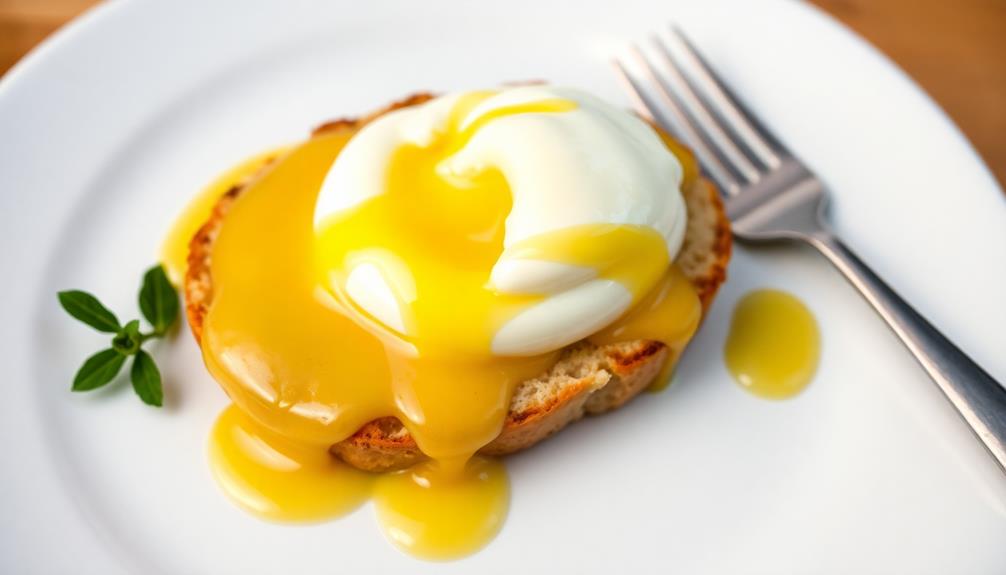
Hollandaise sauce is a rich and creamy emulsion made from egg yolks, butter, and lemon juice. It's a classic French sauce that's commonly served with eggs Benedict, asparagus, and other brunch and dinner dishes. Mastering the technique to create a perfectly smooth and velvety Hollandaise can be challenging, but the result is well worth the effort.
Butter plays a crucial role in enhancing the flavor and texture of this sauce, contributing to its luxurious mouthfeel and rich taste. The key to success lies in slowly and gently cooking the egg yolks while continuously whisking to create a stable emulsion.
Butter enhances flavor and patience and attention to detail are crucial, as overheating the sauce can cause it to break or curdle.
Ingredients:
- 3 large egg yolks
- 1 tablespoon lemon juice
- 1/2 teaspoon Dijon mustard
- 1/2 cup (1 stick) unsalted butter, melted and warm
Cooking Instructions:
In a medium-sized bowl, whisk together the egg yolks, lemon juice, and Dijon mustard until well combined. Place the bowl over a saucepan of gently simmering water, making sure the bottom of the bowl doesn't touch the water.
Continuously whisk the mixture, being careful not to overheat, until it begins to thicken and emulsify, about 3-5 minutes.
Once the sauce has thickened, slowly drizzle in the warm melted butter while whisking constantly. Continue to whisk until the sauce is smooth and creamy. If the sauce becomes too thick, you can thin it out by whisking in a small amount of warm water.
Season with salt and white pepper to taste.
It's important to serve the Hollandaise sauce immediately, as it can break or curdle if it sits for too long. Consider keeping the sauce warm by placing the bowl over a pan of warm water during serving. Enjoy your perfectly crafted Hollandaise sauce!
Cooking Steps

Now it's time to whisk those egg yolks and lemon juice together until they're smooth and creamy.
Then, slowly drizzle in that melted butter, whisking constantly, until the sauce thickens.
Don't forget to stir in your seasonings and adjust the consistency to your liking.
Step 1. Whisk Egg Yolks and Lemon Juice

To start off the process of perfecting the Hollandaise sauce, you'll need to whisk together the egg yolks and lemon juice.
Begin by separating the eggs, carefully setting aside the whites for another use. In a medium-sized bowl, add the yolks and a few squeezes of fresh lemon juice.
Using a sturdy whisk, start vigorously whisking the mixture. As you whisk, the yolks will thicken and transform into a smooth, creamy consistency.
Keep a close eye on the bowl, as the heat from your whisking will gently cook the yolks. Whisk continuously until the mixture has tripled in volume and has a light, velvety texture.
This step is crucial for achieving the signature silky mouthfeel of the Hollandaise.
Once the yolks are perfectly emulsified, you're ready to move on to the next step of slowly incorporating the warm butter to create the ultimate luxurious sauce.
Step 2. Slowly Whisk in Melted Butter

With the egg yolks perfectly emulsified, you'll slowly incorporate the melted butter to create the signature richness and velvety texture of Hollandaise sauce.
First, make sure the butter is melted and warm, but not boiling hot. You'll want to add it to the egg yolk mixture in a slow, steady stream, whisking constantly to prevent the sauce from separating.
It's important to go slowly, incorporating the butter bit by bit, to allow the yolks to absorb each addition. As the sauce thickens, you can increase the speed of the whisk slightly, but be careful not to overheat the mixture.
The end result should be a smooth, creamy Hollandaise with a luscious mouthfeel. If the sauce starts to look broken or curdled, don't worry – you can whisk in a teaspoon of warm water to bring it back together.
With patience and practice, you'll be pouring this decadent sauce over your poached eggs, asparagus, and more in no time.
Step 3. Whisk in Seasonings and Adjust Consistency
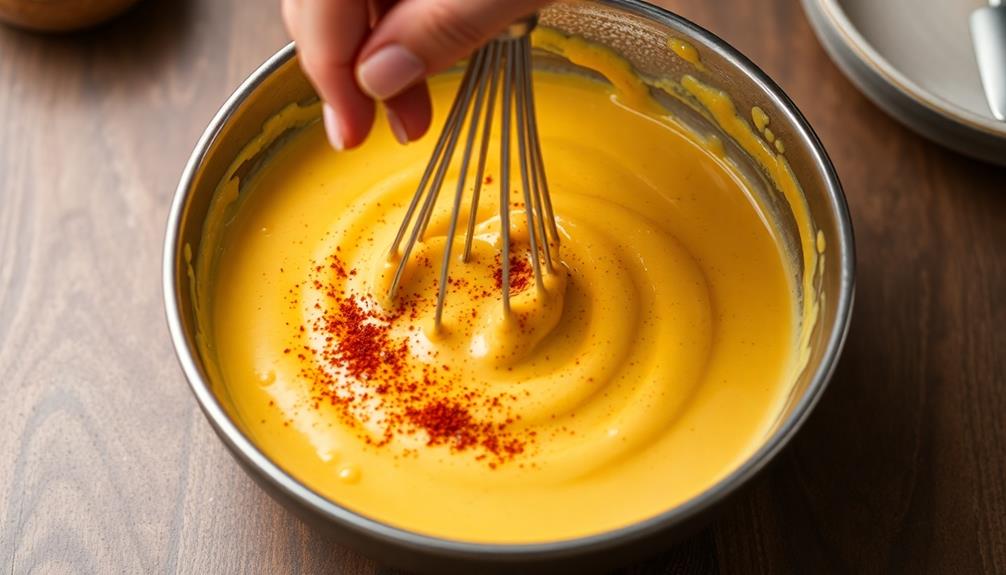
Once the butter is fully incorporated, go ahead and whisk in the seasonings. First, add a pinch of salt and a dash of white pepper to the velvety emulsion. Whisk vigorously to combine. Taste and adjust the seasoning as needed – you want a perfectly balanced flavor that enhances the richness of the hollandaise.
Next, consider the consistency. If the sauce seems too thick, slowly whisk in a teaspoon or two of warm water to thin it out. Conversely, if it's too thin, let the hollandaise sit for a minute, allowing it to thicken up.
You're aiming for a luxuriously creamy texture that coats the back of a spoon. Keep whisking and tasting, fine-tuning the seasoning and consistency until it's absolute perfection.
This is the moment where your hollandaise transforms from good to great – a silky-smooth, flavor-packed sauce that will elevate your dish to new heights. Ready to drizzle? Your eggs have never looked so inviting.
Step 4. Gently Heat the Hollandaise Sauce

After seasoning the hollandaise to perfection, you'll need to gently heat the sauce to ensure it's warm and creamy.
Start by placing the bowl with the hollandaise over a saucepan of barely simmering water, making sure the bowl doesn't touch the water. Whisk the sauce continuously, being careful not to overheat it. The key is to maintain a gentle, consistent heat that slowly warms the sauce, allowing the butter to melt and emulsify.
As the sauce heats, you'll notice it beginning to thicken and become silky smooth.
Keep a close eye on the temperature, removing the bowl from the heat intermittently to prevent the eggs from scrambling. The hollandaise should reach a velvety, pourable consistency that coats the back of a spoon.
If it seems too thick, you can add a teaspoon of warm water to thin it out. Remember, patience and gentle heat are essential for achieving the perfect hollandaise texture.
Step 5. Serve Warm Over Poached Eggs

The perfectly warmed hollandaise sauce is now ready to be drizzled over your beautifully poached eggs.
Tilt the bowl, allowing the silky, golden-yellow sauce to gracefully cascade down the sides of the eggs, creating a mouthwatering contrast with the delicate, pillowy whites. As the sauce gently clings to the eggs, you can almost smell the rich, buttery aroma wafting up, signaling the perfect moment to take your first delightful bite.
With each forkful, the hollandaise's velvety texture melts in your mouth, complementing the soft, runny yolks. The harmonious balance of flavors and textures will have your taste buds dancing with delight.
Savor every moment, as the hollandaise's bright, lemony notes awaken your senses and elevate the humble poached egg into a truly decadent culinary experience. Indulge in this sublime pairing, and enjoy the perfect start to your day.
Final Thoughts
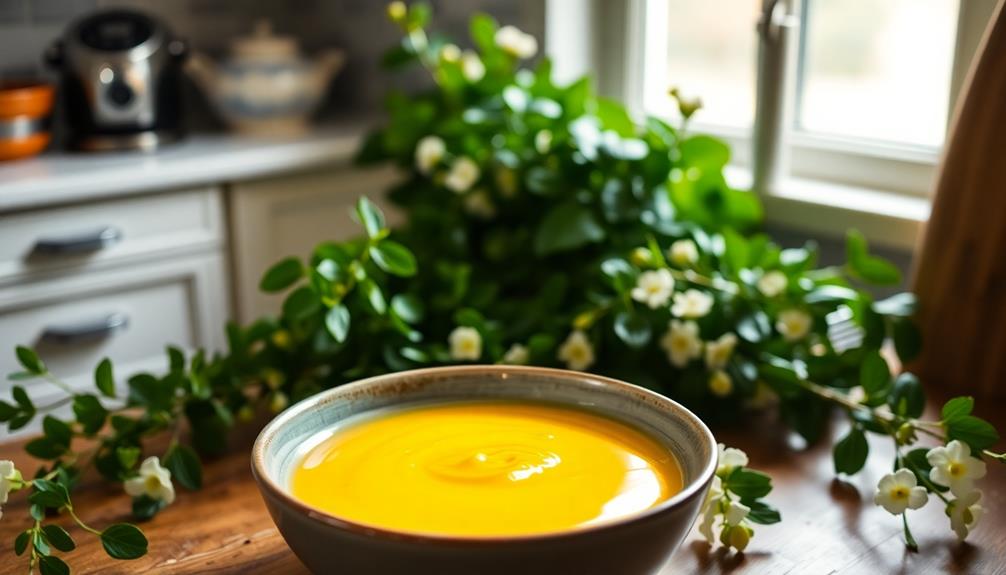
Hollandaise sauce, the crown jewel of brunch menus, requires mastery and precision to achieve its velvety texture and rich, balanced flavor.
While crafting the perfect batch may seem daunting, with a bit of practice, you'll be whipping up this luscious condiment with confidence.
Remember, the key lies in patience and attention to detail – don't rush the process, and be mindful of each step.
Drizzle the warm, golden sauce over tender poached eggs, crispy hash browns, or delicate asparagus spears for a truly indulgent experience.
Your guests will be wowed by your culinary prowess.
Experiment with flavors, too – a touch of lemon zest or a sprinkle of paprika can elevate the classic.
Hollandaise is a versatile staple that deserves a place in every home cook's repertoire.
Embrace the challenge, trust the process, and savor the creamy, dreamy results.
Your brunch game will never be the same.
Frequently Asked Questions
How Long Does Hollandaise Sauce Last in the Fridge?
Hollandaise sauce typically lasts 2-3 days in the fridge when stored properly. Keep it chilled and use it within a few days for best quality and food safety. Don't let it sit out too long.
Can I Make Hollandaise Sauce Ahead of Time?
You can definitely make hollandaise sauce ahead of time, but it's best to use it within a day or two. The sauce can be refrigerated for 2-3 days, though its texture and flavor may degrade over time.
What Are Some Alternative Uses for Hollandaise Sauce?
You can use hollandaise sauce as a topping for roasted vegetables, grilled fish, or even as a dip for artichoke leaves. It also makes a delicious sauce for eggs benedict or crab cakes.
Can I Substitute Ingredients in the Hollandaise Sauce Recipe?
You can certainly substitute ingredients in the hollandaise sauce recipe. Feel free to experiment with different types of fat, acids, or seasonings to create your own unique flavor profile. Just be mindful of the sauce's delicate balance.
How Do I Reheat Hollandaise Sauce Without It Breaking?
To reheat hollandaise sauce without it breaking, you can gently heat it over low heat, whisking continuously. Alternatively, you can place the sauce in a bowl over simmering water and whisk until it's warmed through, being careful not to overheat it.

